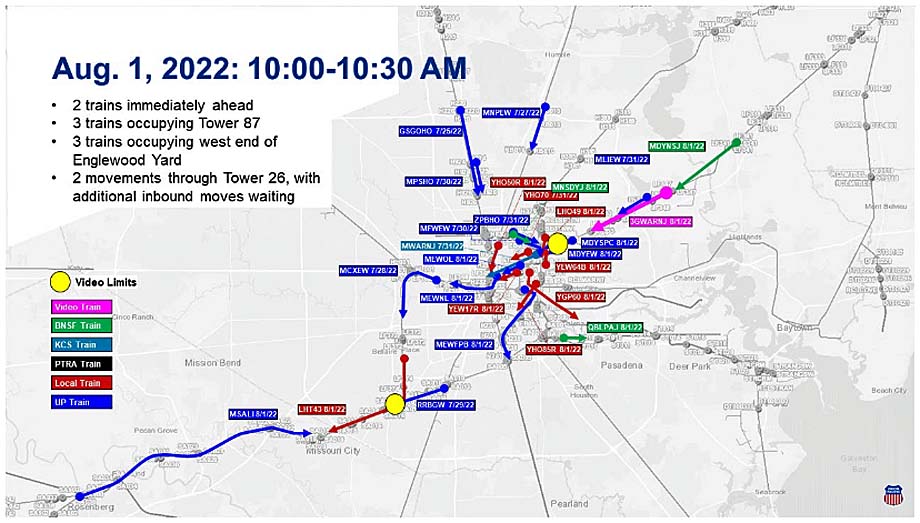
Washington District of Columbia USA - Union Pacific has taken issue with a video that CP and KCS
showed federal regulators of a KCS grain train "breezing through Houston."
The railroads played the video, shot from the lead locomotive, for the Surface Transportation Board (STB) on the sixth
day of their merger hearings earlier this month.
CP and KCS were aiming to show that Houston can handle the eight additional trains they plan on running through the
terminal within three years after their merger.
But UP says the video painted an incomplete picture that suggested there's minimal traffic on KCS trackage rights
routes through Houston.
UP and BNSF Railway contend that the additional trains will bring the complex Houston terminal to its knees without
capacity projects that CPKC should fund.
The increase, they said, would in some areas significantly top peak daily train counts from 2016.
"They are courting disaster," UP wrote in its final brief, which was posted to the STB website on
Monday.
UP told the STB that CP and KCS won't acknowledge the capacity problem.
"Applicants' efforts extended to the hearing, where they presented a video purporting to show a KCS train breezing
through Houston in 74 minutes. Applicants' presentation was either intentionally misleading or exceptionally
uninformed," UP wrote.
The video covered the run of the CP-KCS interline grain train from the east end of UP's Englewood Yard to West
Junction, the last interlocking Laredo-bound trains face in the terminal.
UP says the video showed "only a sliver of the KCS train's run through the Houston area."
Left out: The train waited almost 2 hours at Dawes, Texas, on the eastern edge of Houston, for trains ahead to clear
before it could proceed into the terminal, and then incurred another nearly 2 hour delay while waiting for a UP local
to serve customers near Rosenberg, Texas, where KCS exits UP trackage rights.
"Applicants' video was also deceptive in suggesting there is minimal train activity on the trackage rights lines
in Houston. Train cab video shows activity within about one-third of a mile of the cab, but train signals keep trains
more than one-third of a mile apart, so the video naturally does not show trains ahead of the KCS train. Also, the
video shows activity in one direction, straight ahead, so it does not show trains being blocked by the KCS
train," UP wrote.

UP's filing included diagrams developed from dispatching records, which showed trains operating on and around
the KCS trackage rights route at the time the grain train was near or in the terminal area.
"As the diagrams show, Applicants' video gave the Board a highly misleading impression of the congestion and
complexity rail carriers face when operating through Houston," UP wrote.
The first diagram shows 15 UP road freights, seven locals, six BNSF road freights, two KCS trains, and a pair of Port
Terminal Railroad Association trains in and around Houston.
Of those, two trains were immediately ahead, three trains were occupying the Tower 87 junction, another three were at
the west end of Englewood Yard, and two trains were moving through Tower 26, with additional moves
waiting.
Nonetheless, the grain train ran between Beaumont and Rosenberg in eight hours, which was faster than the 2022 average
of 9.2 hours, UP said.
UP also said CP and KCS showed "a lack of knowledge about the challenges of adding capacity in
Houston."
CP CEO Keith Creel referred to Englewood Yard as a "field of dreams" where UP could quickly lengthen
receiving and departure tracks to accommodate long trains that currently tie up one or both of the two mains while
yarding.
"UP is planning such a project, but Applicants are apparently unaware that the project cannot proceed until
significant environmental issues are resolved. Reflecting their cavalier approach to the entire question of capacity in
the constrained Houston complex, Applicants did not bother to study the detailed facts that will affect their
operations in Houston," UP wrote.
The area around Englewood Yard is contaminated with creosote.
Southern Pacific operated a tie facility on the site for years, and UP is in the midst of a 30 year remediation
project.
Area residents have filed a US$100 million lawsuit against the railroad regarding exposure to toxins.
CP and KCS say they've studied capacity on UP trackage rights routes between Beaumont and Robstown, Texas, including
Houston, and concluded that there is room for additional traffic.
"The specter put forward by UP and BNSF, analogizing to the 1997-1998 Houston service meltdown, is scare
mongering that is entirely self-serving and divorced from the realities of present circumstances. Unlike in UP/SP, CPKC
will not be reconfiguring the entire Houston rail network with terminal consolidations and other extensive changes on
top of a fragile SP network. CPKC will merely be increasing, in a measured way over the course of three years, the
number of through trains it runs across the expressway routes to which Tex Mex was granted equal rights in
1996," CP and KCS said in their final brief."
Existing frameworks for capacity expansion projects on shared trackage are adequate for identifying and funding
necessary work, CP and KCS say.
Bill Stephens.
(likely no image with original article)
(usually because it's been seen before)
provisions in Section 29 of the Canadian
Copyright Modernization Act.

